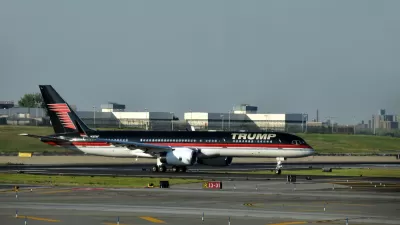While he has yet to explain how he would pay for the plan, the 'anti-regulation' president did add a costly and controversial requirement on Tuesday — a 'Buy America' provision that likely extends beyond the existing regulation.

As expected, President Trump announced his infrastructure plan on Feb. 28 during his address to a joint session of Congress:
“To launch our national rebuilding, I will be asking Congress to approve legislation that produces a $1 trillion investment in infrastructure of the United States, financed through both public and private capital, creating millions of new jobs,” stated the president to applause from both sides of the aisle.
"But Trump still didn’t answer the question pretty much everyone has asked since he started promising big investments in infrastructure: How will the federal government pay for his ideal plan?" reports Brianna Gurciullo, with help from Tanya Snyder, for POLITICO Morning Transportation. Nonetheless, the announcement was revealing, according to NPR National Desk reporter David Schaper, whose notes appear in an annotated version of the president's address:
This is the first time the president has suggested public financing will be needed in addition to private investment to fix and rebuild the nation’s infrastructure, but it is still unclear where that money will come from. There is significant opposition within Trump’s own party in Congress to raising gasoline and diesel taxes, and there is some opposition in his own party to increasing tolling on the nation’s highways, bridges and other infrastructure — a key way to leverage private funding for infrastructure.
President Trump did add one detail to the plan that, ironically, will increase construction costs:
"This effort will be guided by two core principles: Buy American and hire American," he announced.
Schaper adds that "President Trump and his administration have not yet explained exactly what 'buy American' will mean when it comes to rebuilding the nation’s infrastructure."
There already are “buy America” requirements in federal law for materials used in federally funded transportation construction projects, especially for U.S.-made steel. Expanding such requirements could significantly increase the costs of rebuilding infrastructure, as we reported Monday.
In that article, Schaper explores the history of the Buy America law, and the expansion of its use if the president has his way. Readers may recall that this is not the first time that President Trump has required the 'buy America' provision: it arose in one of his first executive actions when he reversed his predecessor's positions on two controversial oil pipelines.
"Domestic-made steel usually out of the mill will cost 70, 80 percent more than Chinese steel out of the mill," says Jeff Davis, senior fellow at the Eno Center for Transportation, a non-partisan policy think tank in Washington, D.C., who has written extensively about "buy America" rules.
For a president to be so "anti-regulation" (see his executive order) and cost-conscious, it is ironic that he would add to the costs of major construction projects by expanding the already burdensome Buy America provision. This provision is so significant that is has been listed as one reason why the United States lacks high-speed rail, according to Construction Drive.
Melanie Zanona, reporting for The Hill in January, indicated that expanding the Buy America provision will likely not go over well with Congress. In fact, she writes that "a Republican-led effort to strip a so-called 'Buy America' rule from a water infrastructure bill was underway in the House."
FULL STORY: Trump's Address To Joint Session Of Congress, Annotated

Alabama: Trump Terminates Settlements for Black Communities Harmed By Raw Sewage
Trump deemed the landmark civil rights agreement “illegal DEI and environmental justice policy.”

Planetizen Federal Action Tracker
A weekly monitor of how Trump’s orders and actions are impacting planners and planning in America.

The 120 Year Old Tiny Home Villages That Sheltered San Francisco’s Earthquake Refugees
More than a century ago, San Francisco mobilized to house thousands of residents displaced by the 1906 earthquake. Could their strategy offer a model for the present?

San Francisco Opens Park on Former Great Highway
The Sunset Dunes park’s grand opening attracted both fans and detractors.

Oregon Legislature to Consider Transit Funding Laws
One proposal would increase the state’s payroll tax by .08% to fund transit agencies and expand service.

Housing Vouchers as a Key Piece of Houston’s Housing Strategy
The Houston Housing Authority supports 19,000 households through the housing voucher program.
Urban Design for Planners 1: Software Tools
This six-course series explores essential urban design concepts using open source software and equips planners with the tools they need to participate fully in the urban design process.
Planning for Universal Design
Learn the tools for implementing Universal Design in planning regulations.
Clanton & Associates, Inc.
Jessamine County Fiscal Court
Institute for Housing and Urban Development Studies (IHS)
City of Grandview
Harvard GSD Executive Education
Toledo-Lucas County Plan Commissions
Salt Lake City
NYU Wagner Graduate School of Public Service





























